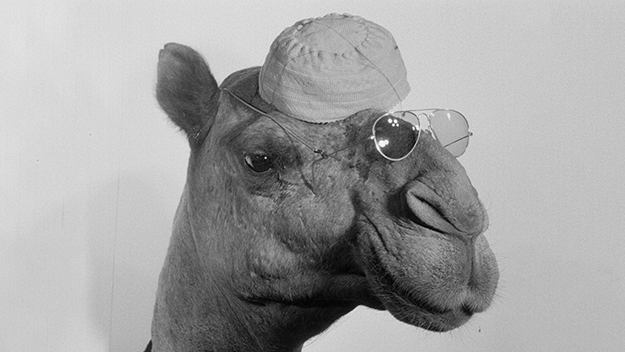Outside, Looking In
This article appeared in the September 7, 2023 edition of The Film Comment Letter, our free weekly newsletter featuring original film criticism and writing. Sign up for the Letter here.

A Camel (Ibrahim Shaddad, 1981)
The Sudanese Film Group was born at the fulcrum of two crises. “No art in recent times has been subject to such oppression as the art of cinema in Sudan,” began the SFG’s founding statement, published in April 1989. Composed by a handful of filmmakers who had trained abroad and returned to work with the country’s Ministry of Culture, this manifesto bemoaned the dire lack of funding, propagandistic pressures, and “limited horizon of officialdom” that curtailed the directors’ artistic ambitions; the SFG, they declared, would be a beacon “against armies of darkness.” Just two months later, however, an even darker night descended upon Sudan and its cinema. The military coup d’état of June 1989 led to three decades of fundamentalist Islamic rule that shut down movie theaters and practically extinguished film culture in the country, sending many of the members of SFG into exile.
Yet even before they officially (and fleetingly) founded the group, the members of SFG—notably Ibrahim Shaddad, Suliman Elnour, and Eltayeb Mahdi—had already accumulated rather remarkable bodies of works, made in film schools in East Germany, Cairo, and Moscow, as well as in Sudan. Though widely diverse in style and content, these films cohere as products of the socialist film networks that flourished during the Cold War, producing avenues of education and exchange between countries united in their resistance to Western imperialism. Long unseen and recently, painstakingly restored by the Arsenal – Institute for Film and Video Art in Berlin, the films—four of which are streaming until September 11 on Metrograph at Home—attempt to reimagine the relationship between cinema and the nation. They drive home a vision of film as a means of reflecting on social and political realities, but they strain against the didactic, and often uncritical, dictates of a state-sanctioned national cinema.
The films that emerged from the directors’ experiences at international film schools are particularly compelling in how they collage forms and concerns drawn from both foreign cinemas and Sudanese art traditions, filtered through their makers’ singular experiences of immigrant life. Ibrahim Shaddad’s graduation film, Hunting Party (1964), is an extraordinary, expressionist riff on the American western, filmed in a forest in Brandenburg. While fleeing a pack of rifle-toting white men, a Black man stumbles upon the hut of a German couple. Their offhand racism notwithstanding, he insinuates himself into their household chores and rhythms until the finale brings the trio’s strange, erotically charged relationship to a violent climax. Nearly wordless, Hunting Party geographically transposes and aesthetically sublimates the traditional narrative of the western. Each moment feels audaciously unpredictable, with sharp zooms and canny angle changes constantly unsettling our perspective, challenging us to reorient our cinematic expectations of racialized characters. In Africa, the Jungle, Drums and Revolution (1977), Suliman Elnour takes a nonfiction route to probe similar questions, weaving together shots of African dances and rituals with man-on-the-street interviews with Russians about their impressions of Africa. The passersby’s answers reveal both political solidarity and exotic interest, while the inserts from Africa—edited into a melodic yet disorienting frenzy—refract those responses onto the viewer, making us question our own impulses and impressions in real time.
Back in Sudan, the SFG filmmakers worked within the constraints of state funding, but managed to turn commissions for tourism films and industrials into sui generis experimental efforts. Shaddad’s indelible A Camel (1981) recalls both the taciturn elegance of Bresson and the jagged montage of Eisenstein with its eerie parable about the ways in which labor mediates our relationship to the natural world. Having pitched a short film about traditional sesame production, Shaddad created a delirious tone-poem about a day in the life of a camel put to work at a mill. The beast’s piercing groan forms a kind of dissonant score, while the edit seems to follow its dizzying, circular grind inside the cramped mill—interrupted by a brief respite in which the animal rests outdoors among other creatures, and we see it in an exuberant series of anthropomorphic poses, wigs, and costumes.
A Camel shares some DNA with Mahdi’s Station (1989)—one of the great classics of the SFG—in the density of ideas it ekes out from a simply, sparsely produced premise. Mahdi’s short is set at one of the crossroads that connects Khartoum to Port Sudan, where a rural family makes a pit stop, seemingly en route to take an ailing relative to the city. They silently pass the time with errands, rituals, and chores, while the intersection bustles with commercial activity. Lovingly close, tactile shots of the villagers shining shoes and breaking bread are interspersed with images of a Shell Oil billboard, gargantuan trucks with gleaming dashboards, and drivers speaking into walkie-talkies. Not much is said in the film, and Mahdi doesn’t belabor any simplistic thesis about modernity and tradition; instead, the film accumulates as a cacophonous and melancholy portrait of the kinds of contradictions that coexist in Third World nations pushed into the inherently uneven terrain of Western capitalism, where people sharing the same piece of land can have entirely different experiences of time and scale. A little visual trick drives home cinema’s unique ability to bear witness to these paradoxes: Mahdi cuts from a shot of one truck to another, but a zoom out reveals the latter vehicle to be a tiny toy, dragged along pitifully on a string by a child.







